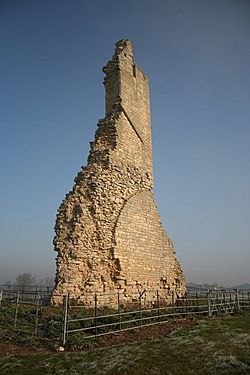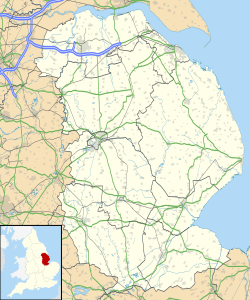Kirkstead Abbey facts for kids

Kirkstead Abbey ruin
|
|
| Monastery information | |
|---|---|
| Order | Cistercian |
| Established | 1139 |
| Disestablished | 1537 |
| Architecture | |
| Status | Ruined |
| Heritage designation | Scheduled Monument 1005050 Grade I listed building 1288192 |
| Completion date | 1187 |
| Site | |
| Location | Woodhall Spa, East Lindsey, Lincolnshire |
| Coordinates | 53°08′18″N 0°13′23″W / 53.138463°N 0.223131°W |
Kirkstead Abbey was once a large Cistercian monastery in Kirkstead, Lincolnshire, England. Today, only ruins remain of this historic site. It was a place where monks lived, worked, and prayed for hundreds of years.
About Kirkstead Abbey
Kirkstead Abbey was founded in 1139 by a man named Hugh Brito. He was the lord of Tattershall. The first monks came from Fountains Abbey in Yorkshire. There were an abbot and twelve monks.
Building the Abbey
The first location chosen for the abbey was not big enough. So, in 1187, Hugh's son Robert found a better spot nearby. The building work was probably finished around 1187. However, the style of the buildings suggests they were started earlier, around 1175. The monks were also given land in Wildmore. This land was given by the lords of Bolingbroke, Scrivelsby, and Horncastle. The monks and their tenants could use this land for grazing animals.
The Abbey's End
Kirkstead Abbey existed until 1537. At this time, King Henry VIII decided to close many monasteries in England. This event is known as the Dissolution of the monasteries. The last abbot of Kirkstead, Richard Harrison, and three monks faced serious consequences. This happened after they were linked to the Pilgrimage of Grace. This was a large protest that took place the year before.
What Remains Today
After the abbey closed, its land went to the Duke of Suffolk. Later, it passed to the Clinton Earls of Lincoln. They built a large country house on the site. By 1791, that house was also gone.
Today, all that is left is a dramatic piece of stone wall. This is a part of the south transept wall of the old abbey church. You can also see the earthworks. These are the bumps and hollows in the ground. They show where the many other buildings once stood. The remains are a Grade I listed building. This means they are very important historically. They are also an ancient scheduled monument. This protects them from being damaged.


